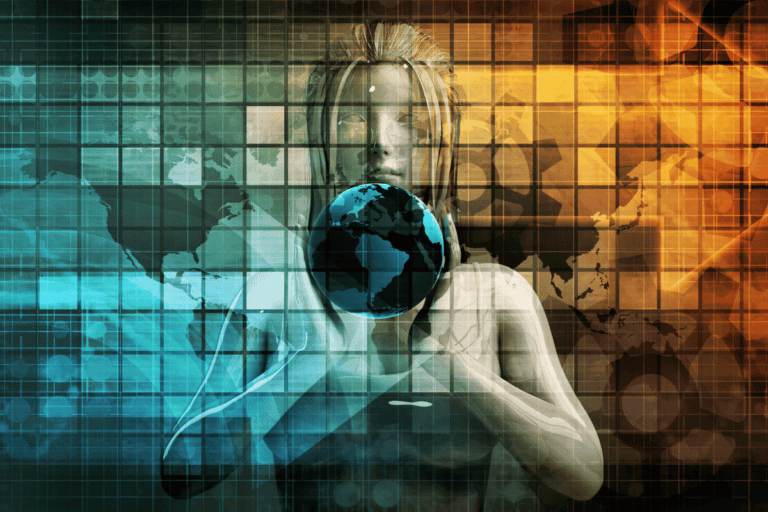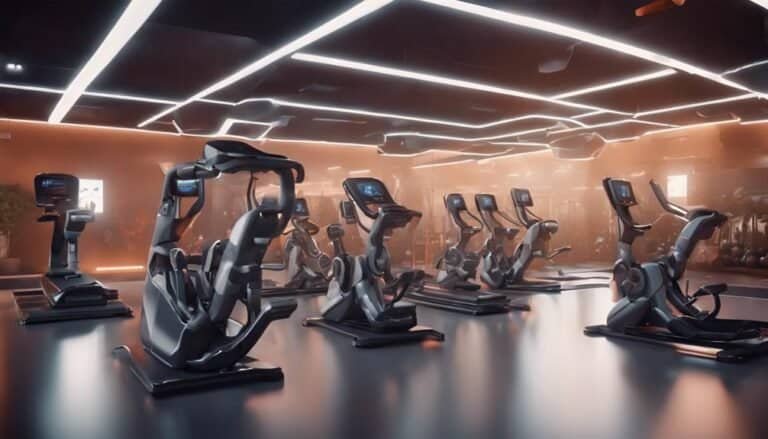Augmented Reality and AI: Enhancing Real-World Experiences
The convergence of augmented reality (AR) and artificial intelligence (AI) has opened new avenues for enhancing real-world experiences across various sectors. From retail to healthcare, education to entertainment, the possibilities seem limitless.
Imagine a future where shopping becomes a personalized, immersive experience, or where educational tools offer interactive learning environments. With AI-powered AR, travel exploration could be transformed into unforgettable adventures, and healthcare practices revolutionized through innovative solutions.
Stay tuned as we explore how these technologies are reshaping industries and redefining social interactions in ways that were once unimaginable.
Key Takeaways
- Retail, education, travel, healthcare, and entertainment sectors benefit from personalized, immersive experiences.
- AR and AI optimize operations in industries, enhancing efficiency, automation, and communication.
- Social interactions are reimagined with real-time language translation, virtual spaces, and AI-powered simulations.
- Communication skills are improved through real-time translation, AI simulations, and interactive learning experiences.
Transforming Retail Experiences
With the integration of augmented reality (AR) and artificial intelligence (AI) technologies, the landscape of retail experiences is undergoing a profound transformation. Personalized shopping experiences are becoming more prevalent as AR and AI allow retailers to gather and analyze customer data to offer tailored product recommendations. Interactive displays are a key component of this transformation, enabling customers to engage with products virtually, visualize how items may look in their own environments, and even try out different styles or colors before making a purchase.
AR and AI technologies are revolutionizing the way consumers interact with brands and products, offering a more immersive and personalized shopping journey. Through interactive displays powered by AR, customers can explore products in a virtual space, receiving detailed information and recommendations based on their preferences and past interactions. This not only enhances the overall shopping experience but also fosters customer loyalty and drives sales by creating a more engaging and convenient process for consumers.
Immersive Educational Tools
The integration of augmented reality (AR) and artificial intelligence (AI) technologies is not only revolutionizing retail experiences but also paving the way for the development of immersive educational tools that enhance learning experiences. By incorporating interactive simulations and AI algorithms, educational tools are becoming more engaging and effective in facilitating learning.
| Interactive Simulations | Benefits |
|---|---|
| Real-world application | Encourages active learning |
| Engaging visuals | Enhances retention of information |
| Personalized feedback | Improves student performance |
These immersive educational tools allow students to delve into real-world scenarios through AR, making learning more interactive and practical. AI algorithms personalize the learning experience, providing tailored feedback to students based on their progress. This level of engagement not only enhances educational outcomes but also nurtures critical thinking and problem-solving skills. By combining AR and AI technologies, educators can create dynamic learning environments that cater to individual learning styles, ultimately revolutionizing the traditional educational landscape.
Enhancing Travel Exploration
Augmented reality and AI technologies have revolutionized travel exploration by offering innovative tools. These include virtual tour guides and interactive destination maps. These advancements enable travelers to navigate unfamiliar places with ease, gaining insights and information in real-time.
Virtual Tour Guides
Enhancing travel exploration through the utilization of virtual tour guides offers a dynamic and immersive way for travelers to engage with new destinations. Virtual tour guides leverage AI to provide personalized recommendations based on travelers' preferences, enhancing their overall experience.
By incorporating interactive storytelling elements, virtual tour guides create a more engaging and informative journey for users. These guides can adapt to individual interests, providing tailored suggestions for attractions, restaurants, and activities.
Through the use of augmented reality and AI technologies, virtual tour guides offer a unique opportunity for travelers to explore destinations in a more interactive and personalized manner. This innovative approach not only enhances the travel experience but also opens up new possibilities for discovering and experiencing different cultures and locations.
Interactive Destination Maps
Interactive destination maps are sophisticated tools that revolutionize travel exploration by offering dynamic and personalized navigation experiences for users. These interactive maps utilize advanced technologies like augmented reality and AI to enhance the way travelers navigate and discover new destinations. By incorporating features such as location tracking and real-time updates, interactive mapping has become an indispensable asset for modern adventurers.
- Personalized Recommendations: Interactive maps provide tailored suggestions based on user preferences.
- Offline Accessibility: Users can access maps offline, ensuring navigation even in areas with limited connectivity.
- Interactive Points of Interest: Users can interact with points of interest on the map for detailed information.
- Customizable Routes: Travelers can create customized routes based on their interests and time constraints.
Revolutionizing Healthcare Practices
Advancements in augmented reality and AI technology are revolutionizing healthcare practices through the implementation of medical training simulations and surgical procedure guidance. These innovations offer healthcare professionals immersive training experiences and real-time assistance during complex procedures, ultimately enhancing patient care and safety.
Medical Training Simulations
The integration of medical training simulations utilizing augmented reality and AI technologies is significantly transforming the landscape of healthcare education and practice. These advancements are offering new ways to enhance learning experiences and improve patient care. Key aspects of this transformation include:
- Virtual patient simulations for hands-on training.
- Medical scenario simulations to aid in skill development.
- Personalized learning experiences tailored to individual needs.
- Real-time feedback and performance evaluation for continuous improvement.
Surgical Procedure Guidance
The utilization of augmented reality and AI technologies in surgical procedure guidance is heralding a new era in revolutionizing healthcare practices. AI-assisted surgeries are becoming more prevalent, allowing for increased precision and efficiency in the operating room. One of the key advantages of incorporating AI into surgical procedures is the ability to provide real-time feedback to surgeons, enhancing decision-making processes and reducing the margin of error. This technology enables surgeons to visualize critical information directly in their field of view, leading to improved outcomes for patients. By harnessing the power of augmented reality and AI, healthcare professionals can advance surgical practices to new heights, ultimately benefiting both medical practitioners and patients.
| Advantages of AI in Surgical Procedures | |
|---|---|
| Enhanced Precision | Real-time Feedback |
| Improved Decision-making | Reduced Margin of Error |
Interactive Entertainment Solutions
Augmented reality and AI technologies are revolutionizing interactive entertainment solutions by creating immersive and engaging experiences for users. These advancements have significantly enhanced virtual gaming experiences and interactive storytelling, transforming how individuals interact with entertainment content.
- Virtual Gaming Experiences: AR and AI technologies have brought an unprecedented level of realism to virtual gaming, blurring the lines between the virtual world and reality. Players can now experience games in a more interactive and engaging manner.
- Interactive Storytelling: These technologies enable storytellers to craft narratives where users play an active role in shaping the storyline, leading to more personalized and dynamic storytelling experiences.
- Live Event Interactions: AR enhances live events by providing interactive elements that engage audiences in real-time, creating a more immersive and memorable experience.
- Real-Time Simulations: AI-powered simulations offer realistic scenarios that adapt and respond to user inputs, providing a dynamic and engaging environment for users to explore and interact with.
Streamlining Industrial Processes
Revolutionizing operational efficiency through the integration of augmented reality and artificial intelligence technologies is a key focus in streamlining industrial processes. Efficiency optimization plays a crucial role in enhancing productivity and reducing operational costs within manufacturing, logistics, and other industrial sectors. By leveraging augmented reality, workers can access real-time data overlays, interactive manuals, and remote assistance, leading to quicker decision-making and improved task execution. This integration allows for streamlined workflows and enhanced communication among team members, ultimately resulting in a more efficient production environment.
Automation integration is another vital aspect of streamlining industrial processes. By incorporating AI-driven automation systems, repetitive tasks can be handled swiftly and accurately, freeing up human workers to focus on more complex and value-added activities. Predictive maintenance powered by AI algorithms enables proactive equipment monitoring, preventing unexpected breakdowns and minimizing downtime. Overall, the combination of augmented reality and artificial intelligence in industrial settings paves the way for increased efficiency, cost savings, and improved overall operational performance.
Redefining Social Interactions
How can the integration of augmented reality and artificial intelligence technologies redefine social interactions in today's interconnected world? As these advanced technologies continue to evolve, they hold the potential to transform how people connect and communicate with each other, enhancing personal connections and refining communication skills.
- Enhanced Personal Connections: AR and AI can facilitate more meaningful interactions by providing insights into social cues and preferences, fostering deeper relationships.
- Improved Communication Skills: Through real-time language translation and contextual prompts, individuals can enhance their ability to convey thoughts and emotions effectively.
- Virtual Social Spaces: AR can create virtual environments where people can gather, socialize, and collaborate regardless of physical distance, expanding social networks.
- Interactive Learning Experiences: AI-powered social interaction simulations can help individuals practice and improve their communication skills in various scenarios, boosting confidence in real-world interactions.
Conclusion
In conclusion, the integration of augmented reality and AI technologies has significantly enhanced various real-world experiences across different industries.
From transforming retail experiences and revolutionizing healthcare practices to redefining social interactions and streamlining industrial processes, these advancements have opened up new possibilities for immersive and interactive engagements.
As these technologies continue to evolve and intersect, the potential for enhancing our daily lives in unexpected ways becomes increasingly promising.







